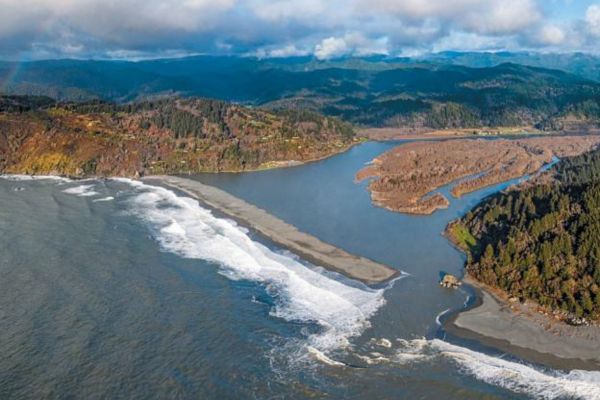Source: https://nativenewsonline.net/environment/three-california-tribal-nations-declare-first-u-s-indigenous-marine-stewardship-area
BY NATIVE NEWS ONLINE STAFF SEPTEMBER 21, 2023
“We do not seek the permission of other governments and can no longer wait to act to preserve and protect this culturally and ecologically important place”
Tri-Tribal Proclamation in designation documents for the Indigenous Marine Stewardship Area
It’s an unprecedented day for Indigenous sovereignty and Indigenous-led coastal conservation as three federally-recognized California Tribal Nations announce the Yurok-Tolowa-Dee-ni’ Indigenous Marine Stewardship Area – the first-ever ocean protection area designated by Tribal governments in the United States.
The Resighini Tribe of Yurok People, Tolowa Dee-ni’ Nation and Cher-Ae Heights Indian Community of the Trinidad Rancheria each took action to protect nearly 700 square miles of their ancestral ocean and coastal territories, and waters to advance long-term Tribal stewardship and governance, as well as Tribal and State co-management of critical ecosystems to protect and support cultural lifeways and economies, while directly addressing climate impacts. The Yurok-Tolowa-Dee-ni’ IMSA stretches from the Oregon and California border to just south of Trinidad in Humboldt County – about 290 miles north of San Francisco – and will directly help the state of California to achieve its biodiversity and durable conservation goals by 2030.
This first Indigenous Marine Stewardship Area (IMSA) in the U.S. and California (IMSA) is home to species of high cultural value to the Tribal nations including mussels, seaweed, kelp, clams, abalone, surf and night smelts, salmon, candlefish, green sturgeon, shorebirds, and eels, or lamprey.
“We do not seek the permission of other governments and can no longer wait to act to preserve and protect this culturally and ecologically important place,” the three Tribes proclaimed in Tribal designation documents for the IMSA announced today from California’s State Capitol on California Native American Day.
In June, the Tsawout First Nation in British Columbia declared an Indigenous Protected and Conserved Area (IPCA) for 155 square kilometers – approximately 60 square miles – of its territorial ocean waters in a substantive move for the reclamation of rights, lands and waters, while other successful Indigenous-led protected areas can be traced back decades globally. The Yurok-Tolowa Dee-ni’ declaration protects more than 11 times the amount of ocean space as the Canadian example – and together, these consequential designations show the Indigenous sovereignty and leadership advancing the protection of 30 percent of waters and lands across North America by 2030.
The Resighini Tribe of Yurok People, Tolowa Dee-ni’ Nation and Cher-Ae Heights Indian Community of the Trinidad Rancheria each acknowledge the need to have direct participation in how their waters and lands are managed, as well as the future of their cultural resources and traditions associated with these sacred places as the climate crisis accelerates.
“This declaration is the culmination of years of hard work to protect our ocean and coastal waters. As Yurok people, we take our stewardship responsibilities very seriously and are proud to work with other sovereign Tribal Governments to do the work we were meant to as Tribal people,” said Fawn C. Murphy, Chairperson, of the Resighini Tribe of Yurok People. “We are so excited to be the leaders in this effort!”
The Yurok-Tolowa Dee-ni’ IMSA designation is the first such Tribal designation in U.S. History – and it aims to safeguard an area under threats, which include sea level rise and coastal erosion, by enhancing Tribal stewardship and applying Traditional Ecological Knowledge (TEK) across a range of important management needs facing the region such as, poor water quality, ocean acidification, species and habitat loss, offshore development, and other climate crisis impacts affecting the health of their communities. The three Tribes are actively involved in several on-going ocean and coastal research and species monitoring projects.
“The intent of IMSAs is to recognize Tribal Governance of unceded ocean and coastal waters through continued stewardship, to support cultural lifeways and economies, to enhance biodiversity, and to provide durable conservation measures designed to protect and restore ocean health that are rooted in Indigenous Traditional Knowledge,” said Jeri Lynn Thompson, Chairperson of the Tolowa Dee-ni’ Nation.
“A resilient marine ecosystem is essential for the well-being and protection of cultural and traditional species of importance to Trinidad Rancheria,” said Garth Sundberg, Chairman of the Trinidad Rancheria. “Since time immemorial, we have honored the inherent balance and interconnectedness of ocean resources and coastal communities. Today, we celebrate this historic action with our partnering sovereign Tribal Governments.”
The resolution reads, in part:
“Our Tribes hereby declare and designate the ocean and coastal territory from what is commonly known as the California – Oregon border (north) to Little River (south), mean high tide (east), and out three (3) nautical miles beyond the outermost islands, reefs, and rocks, and including all waters between those and the coast (west), which encompasses to be the Yurok – Tolowa Dee-ni′ Indigenous Marine Stewardship Area or IMSA; and be it further resolved, these waters are also claimed by the State of California, who through its California Natural Resources Agency Pathways to 30×30: Accelerating Conservation of California’s Nature Report, support the concept of Indigenous Marine Stewardship.”
The Tribes also acknowledge that there are other Tribal Nations who share this ocean space and have welcomed those Tribes to participate at any time in the future.
